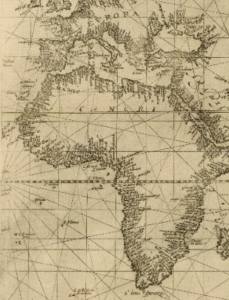 [Here is the first of American Friends of the Hakluyt Society’s “Working with Hakluyt” posts, on teaching Hakluyt as an editor, written by Dr. Mary Fuller of MIT.] What can we do with Principal Navigation and why would we want to do it? The scholarly landscape of 2021 offers a world of new affordances and new questions. I’ll tackle one of them: if only a small proportion of Hakluyt’s sources are original to PN,what kinds of questions are enabled by looking at a text in the context of the compilation? Richard Eden’s narrative of a voyage to West Africa in 1554 provides a rich example: originally published in his 1555 Decades, it informs both on Eden’s authorship and on his editorial treatment of Africa. This narrative unites three sources: the editor’s reading about Africa in classical sources, an anonymous log, and the reported testimony of “our men.” Eden didn’t seek to reconcile their disparities; rather, his framing text echoes and elevates the authority of his pejorative (and often-cited) second- and third-hand knowledge over that of first-person witnesses. In Hakluyt’s reprinted version, some 45 years later, reports on subsequent voyages help to flesh out Eden’s narrative. Some of the five African men kidnapped in 1554 became brokers for Anglo-African trade in 1555; communities also reacted to their capture. We can discern from details in PN that the editor knew more about the voyage than Eden had reported, suggesting that he located and drew on archival or oral testimony. Read more here…
[Here is the first of American Friends of the Hakluyt Society’s “Working with Hakluyt” posts, on teaching Hakluyt as an editor, written by Dr. Mary Fuller of MIT.] What can we do with Principal Navigation and why would we want to do it? The scholarly landscape of 2021 offers a world of new affordances and new questions. I’ll tackle one of them: if only a small proportion of Hakluyt’s sources are original to PN,what kinds of questions are enabled by looking at a text in the context of the compilation? Richard Eden’s narrative of a voyage to West Africa in 1554 provides a rich example: originally published in his 1555 Decades, it informs both on Eden’s authorship and on his editorial treatment of Africa. This narrative unites three sources: the editor’s reading about Africa in classical sources, an anonymous log, and the reported testimony of “our men.” Eden didn’t seek to reconcile their disparities; rather, his framing text echoes and elevates the authority of his pejorative (and often-cited) second- and third-hand knowledge over that of first-person witnesses. In Hakluyt’s reprinted version, some 45 years later, reports on subsequent voyages help to flesh out Eden’s narrative. Some of the five African men kidnapped in 1554 became brokers for Anglo-African trade in 1555; communities also reacted to their capture. We can discern from details in PN that the editor knew more about the voyage than Eden had reported, suggesting that he located and drew on archival or oral testimony. Read more here…
How to Teach Hakluyt’s Editing with Prof Mary Fuller
Published on: October 8, 2021
